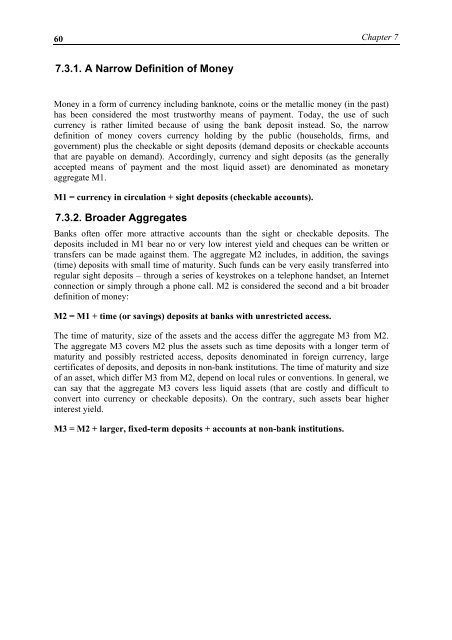MacroeconomicsI_working_version (1)
You also want an ePaper? Increase the reach of your titles
YUMPU automatically turns print PDFs into web optimized ePapers that Google loves.
60<br />
Chapter 7<br />
7.3.1. A Narrow Definition of Money<br />
Money in a form of currency including banknote, coins or the metallic money (in the past)<br />
has been considered the most trustworthy means of payment. Today, the use of such<br />
currency is rather limited because of using the bank deposit instead. So, the narrow<br />
definition of money covers currency holding by the public (households, firms, and<br />
government) plus the checkable or sight deposits (demand deposits or checkable accounts<br />
that are payable on demand). Accordingly, currency and sight deposits (as the generally<br />
accepted means of payment and the most liquid asset) are denominated as monetary<br />
aggregate M1.<br />
M1 = currency in circulation + sight deposits (checkable accounts).<br />
7.3.2. Broader Aggregates<br />
Banks often offer more attractive accounts than the sight or checkable deposits. The<br />
deposits included in M1 bear no or very low interest yield and cheques can be written or<br />
transfers can be made against them. The aggregate M2 includes, in addition, the savings<br />
(time) deposits with small time of maturity. Such funds can be very easily transferred into<br />
regular sight deposits – through a series of keystrokes on a telephone handset, an Internet<br />
connection or simply through a phone call. M2 is considered the second and a bit broader<br />
definition of money:<br />
M2 = M1 + time (or savings) deposits at banks with unrestricted access.<br />
The time of maturity, size of the assets and the access differ the aggregate M3 from M2.<br />
The aggregate M3 covers M2 plus the assets such as time deposits with a longer term of<br />
maturity and possibly restricted access, deposits denominated in foreign currency, large<br />
certificates of deposits, and deposits in non-bank institutions. The time of maturity and size<br />
of an asset, which differ M3 from M2, depend on local rules or conventions. In general, we<br />
can say that the aggregate M3 covers less liquid assets (that are costly and difficult to<br />
convert into currency or checkable deposits). On the contrary, such assets bear higher<br />
interest yield.<br />
M3 = M2 + larger, fixed-term deposits + accounts at non-bank institutions.




